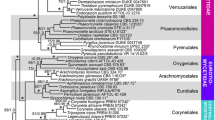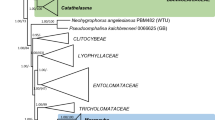Abstract
The lichenicolous anamorphic fungus Sclerococcum parmeliae was isolated in pure culture, and ITS, nuLSU and mtSSU sequences were obtained from these isolates. For comparison, sequences from S. sphaerale, the generic type, were obtained directly from freshly collected specimens. Phylogenetic analyses place S. sphaerale with species of Dactylospora and an unidentified lichen-inhabiting isolate in a strongly supported clade that is sister to a lineage comprising members of the Chaetothyriales and Pyrenulales. In contrast, S. parmeliae is inferred as a member of the Herpotrichiellaceae (Chaetothyriales) and belongs to a robustly supported clade that also includes species of Cladophialophora, Capronia semiimmersa, and Phialophora verrucosa. Within the Herpotrichiellaceae, S. parmeliae most closely resembles members of the anamorph genus Cladophialophora. Accordingly, we propose the transfer of S. parmeliae and the morphologically similar species S. cladoniae, S. hawksworthii and S. normandinae to Cladophialophora. A new lichenicolous species, Clad. megalosporae, collected twice on Megalospora in Florida and Papua New Guinea, is also described.





Similar content being viewed by others
References
Altschul SF, Gish W, Miller W, Myers EW, Lipman DJ (1990) Basic local alignment search tool. J Mol Biol 215:403–410
Badali H, Gueidan C, Najafzadeh MJ, Bonifaz A, Gerrits van den Ende AHG, de Hoog GS (2008) Biodiversity of the genus Cladophialophora. Stud Mycol 61:175–191
Badali H, Carvalho VO, Vicente V, Attili-Angelis D, Kwiatkowski IB, Gerrits van den Ende AHG, de Hoog GS (2009) Cladophialophora saturnica sp. nov., a new opportunistic species of Chaetothyriales revealed using molecular methods. Med Mycol 47:55–66
Brunauer G, Blaha J, Hager A, Türk R, Stocker-Wörgötter E, Grube M (2007) An isolated lichenicolous fungus forms lichenoid structures when co-cultured with various coccoid algae. Symbiosis 44:127–136
Crous PW, Schubert K, Braun U, de Hoog GS, Hocking AD, Shin HD, Groenewald JZ (2007) Opportunistic, human-pathogenic species in the Herpotrichiellaceae are phenotypically similar to saprobic or phytopathogenic species in the Venturiaceae. Stud Mycol 58:185–217
de Hoog GS, Nishikaku AS, Fernandez-Zeppenfeldt G, Padín-González C, Burger E, Badali H, Richard-Yegres N, Gerrits van den Ende AHG (2007) Molecular analysis and pathogenicity of the Cladophialophora carrionii complex, with the description of a novel species. Stud Mycol 58:219–234
Diederich P (2010) Sclerococcum cladoniae, a new lichenicolous hyphomycete on Cladonia from Luxembourg. Bull Soc Nat Luxemb 111:57–59
Etayo J (1995) Two new species of lichenicolous fungi from the Pyrenees. Nova Hedwigia 61:189–197
Etayo J (2002) Aportación al conocimiento de los hongos liquenícolas de Colombia. Bibl Lichenol 84:1–154
Etayo J, Calatayud V (1998) Sclerococcum (Deuteromycotina) with black sporodochia in Spain. Ann Naturhist Mus Wien 100B:677–681
Etayo J, Diederich P (1995) Lichenicolous fungi from the western Pyrenees, France and Spain. I. New species of deuteromycetes. In: Daniëls FJA, Schulz M, Peine J (eds) Flechten Follmann. Contributions to lichenology in honour of Gerhard Follmann. Geobotanical and Phytotaxonomical Study Group, Botanical Institute, University of Cologne, Cologne, pp 205–221
Etayo J, Diederich P (1996) Lichenicolous fungi from the western Pyrenees, France and Spain. II. More deuteromycetes. Mycotaxon 60:415–428
Etayo J, Sancho LG (2008) Hongos liquenícolas del Sur de Sudamérica, especialmente de Isla Navarino (Chile). Bibl Lichen 98:1–302
Gueidan C, Ruibal Villaseñor C, de Hoog GS, Gorbushina AA, Untereiner WA, Lutzoni F (2008) A rock-inhabiting ancestor for mutualistic and pathogen-rich fungal lineages. Stud Mycol 61:111–119
Hafellner J (1996) Bemerkenswerte Funde von Flechten und lichenicolen Pilzen auf makaronesischen Inseln V. Über einige Neufunde und zwei neue Arten. Herzogia 12:133–145
Hawksworth DL (1975) A revision of lichenicolous fungi accepted by Keissler in Coniothecium. Trans Br Mycol Soc 65:219–238
Hawksworth DL (1979) The lichenicolous hyphomycetes. Bull Br Mus Nat Hist Bot Ser 6:183–300
Hawksworth DL, Jones D (1981) Sclerococcum sphaerale obtained in pure culture. Trans Br Mycol Soc 77:485–489
Jeanmougin F, Thompson JD, Gouy M, Higgins DG, Gibson TJ (1998) Multiple sequence alignment with Clustal X. Trends Biochem Sci 23:403–405
Lawrey JD, Binder M, Diederich P, Molina MC, Sikaroodi M, Ertz D (2007) Phylogenetic diversity of lichen-associated homobasidiomycetes. Mol Phylogenet Evol 44:778–789
Müller E, Petrini O, Fisher PJ, Samuels GJ, Rossman AY (1987) Taxonomy and anamorphs of the Herpotrichiellaceae with notes on generic synonymy. Trans Br Mycol Soc 88:63–74
Rambaut A (2002) Se-Al sequence alignment editor. Version 2.0a11. Available at http://tree.bio.ed.ac/software/seal
Ruibal C, Platas G, Bills GF (2005) Isolation and characterization of melanized fungi from limestone formations in Mallorca. Mycol Prog 4:23–38
Ruibal C, Platas G, Bills GF (2008) High diversity and morphological convergence among melanised fungi from rock formations in the Central Mountain System of Spain. Persoonia 21:93–110
Schoch C, Sung GH, López-Giráldez F, Townsend JP, Miadlikowska J, Hofstetter V, Robbertse B, Matheny B, Kauff F, Wang Z, Gueidan C, Andrie RM, Trippe K, Ciufetti LM, Wynns A, Fraker E, Hodkinson BP, Bonito G, Groenewald JZ, Arzanlou M, De Hoog GS, Crous PW, Hewitt D, Pfister D, Peterson K, Gryzenhout M, Wingfield MJ, Aptroot A, Suh SO, Blackwell M, Hillis DM, Griffith GW, Castlebury LA, Rossman A, Lumbsch HT, Lücking R, Büdel B, Rauhut A, Diederich P, Ertz D, Geiser DM, Hosaka K, Inderbitzin P, Kohlmeyer J, Volkmann-Kohlmeyer B, Mostert L, O’Donnell K, Sipman H, Rogers JD, Shoemaker R, Sugiyama J, Summerbell RC, Untereiner W, Johnston PR, Stenroos S, Zuccaro A, Dyer PS, Crittenden PD, Cole MS, Hansen K, Trappe JM, Yahr R, Lutzoni F, Spatafora JW (2009) The Ascomycota tree of life: a phylum-wide phylogeny clarifies the origin and evolution of fundamental reproductive and ecological traits. Syst Biol 58:224–239
Seifert K, Morgan-Jones G, Gams W, Kendrick B (2011) The genera of hyphomycetes. CBS–KNAW Fungal Biodiversity Centre, Utrecht
Smith CW (2009) Sclerococcum Fr. (1825). In: Smith CW et al (eds) The Lichens of Great Britain and Ireland. The British Lichen Society, London, p 837
Swofford DL (2002) PAUP*. Phylogenetic analysis using parsimony (*and other methods). Version 4. Sinauer Associates, Sunderland
Untereiner WA, Naveau FA (1999) Molecular systematics of the Herpotrichiellaceae with an assessment of the phylogenetic positions of Exophiala dermatitidis and Phialophora americana. Mycologia 91:67–83
Untereiner WA, Gueidan C, Orr MJ, Diederich P (2011) The phylogenetic position of the lichenicolous ascomycete Capronia peltigerae. Fungal Divers 49:225–233
Yoshimura I, Yamamoto Y, Nakano T, Finnie J (2002) Isolation and culture of lichen photobionts and mycobionts. In: Kranner I, Beckett RP, Varma AK (eds) Protocols in Lichenology: culturing, biochemistry, physiology and use in biomonitoring. Springer, Berlin, pp 3–33
Zoller S, Scheidegger C, Sperisen C (1999) PCR primers for the amplification of mitochondrial small subunit ribosomal DNA of lichen-forming ascomycetes. Lichenologist 31:511–516
Acknowledgments
We thank the curators of herbaria and the owners of private collections for the loan of specimens in their care, and the curator of GZU for searching for the voucher specimen of culture ALr-1. This study was supported by NSF grant DEB 0841405 to JDL and a Discovery Grant to WAU from the Natural Science and Engineering Research Council (NSERC) of Canada.
Author information
Authors and Affiliations
Corresponding author
Rights and permissions
About this article
Cite this article
Diederich, P., Ertz, D., Lawrey, J.D. et al. Molecular data place the hyphomycetous lichenicolous genus Sclerococcum close to Dactylospora (Eurotiomycetes) and S. parmeliae in Cladophialophora (Chaetothyriales). Fungal Diversity 58, 61–72 (2013). https://doi.org/10.1007/s13225-012-0179-4
Received:
Accepted:
Published:
Issue Date:
DOI: https://doi.org/10.1007/s13225-012-0179-4




